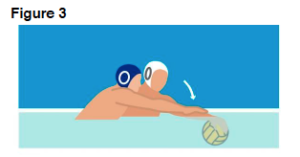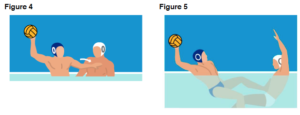WP21 Ordinary Fouls
WP 21.1 It shall be an ordinary foul to commit any of the following offences (WP 21.2 to WP 21.17), which shall be punished by awarding of a free throw to the opposing team.
[NOTE: The referees must award ordinary fouls in accordance with the Rules to enable the attacking team to develop an advantage situation. However, the referees must have regard to the special circumstance of WP 7.3 (Advantage).]
WP 21.2 To advance beyond the goal line at the start of a period, before the referee has given the signal to start. The free throw shall be taken from the location of the ball or, if the ball has not been released into the field of play, from the half distance line.
WP 21.3 To assist a player at the start of a period or at any other time during the game.
WP 21.4 To hold or push off from the goal posts or their fixtures, to hold or push off from the sides or ends of the pool during actual play or at the start of a period.
WP 21.5 To take any active part in the game when standing on the floor of the pool, to walk when play is in progress or to jump from the floor of the pool to play the ball or tackle an opponent. This Rule shall not apply to the goalkeeper while within the goalkeeper’s 6 metre area.
WP 21.6 (See 2023 update below) To take or hold the entire ball under the water when tackled.
[NOTE: It is an ordinary foul to take or hold the ball under the water when tackled, even if the player holding the ball has the ball forced under the water as a result of the opponent’s challenge (figure 3). It makes no difference that the ball goes under the water against the player’s will. What is important is that the foul is awarded against the player who was in contact with the ball at the moment it was taken under the water. It is important to remember that the offence can only occur when a player takes the ball under when tackled. Thus, if the goalkeeper emerges high out of the water to save a shot and then while falling back takes the ball under the water, the goalkeeper has committed no offence; but if the goalkeeper then holds the ball under the water when challenged by an opponent, the goalkeeper will have committed an infringement of this Rule and if the goalkeeper’s actions prevented a probable goal, a penalty throw must be awarded under WP 23.2.]

(Updated 2023) WP21.6 Ordinary foul if a player deliberately hides the ball from the opposing team.
WP 21.7 To strike at the ball with a clenched fist. This Rule shall not apply to the goalkeeper while within the goalkeeper’s 6 metre area.
WP 21.8 To play or touch the ball with two hands at the same time. This Rule shall not apply to the goalkeeper while within the goalkeeper’s 6 metre area.
WP 21.9 To push or push off from an opponent who is not holding the ball.
[NOTE: Pushing can take place in various forms, including with the hand (figure 4) or with the foot (figure 5). In the cases illustrated, the punishment is a free throw for an ordinary foul. However, referees must take care to differentiate between pushing with the foot and kicking – which then becomes an exclusion foul or even brutality. If the foot is already in contact with the opponent when the movement begins, this will usually be pushing, but if the movement begins before such contact with the opponent is made, then this should generally be regarded as kicking.]

WP 21.10 To be within two metres of the opponents’ goal line except when behind the line of the ball. It shall not be an offence if a player takes the ball into the 2 metre area and passes it to another player who is behind the line of the ball and who shoots at goal immediately, before the first player has been able to leave the 2 metre area.
[NOTE: If the player receiving the pass does not shoot at goal, the player who passed the ball must immediately leave the 2 metre area to avoid being penalised under this Rule.]
- UPDATED 2023 – WP1.2 and WP21.10 A new ‘Goal area’ is defined as a rectangular box extending to two metres from the lateral outsides of the goal posts to the two metre line. Ordinary foul if a player goes within the goal area except behind the line of the ball. Players can go inside the 2m line if outside the goal area.
WP 21.11 To take a penalty throw other than in the prescribed manner.
[NOTE: See WP 24.4 for method of taking a penalty throw.]
WP 21.12 To delay unduly when taking a free throw, goal throw or corner throw.
[NOTE: See note to WP 17.2]
WP 21.13 To last touch the ball that goes out of the side of the field of play (including the ball rebounding from the side of the field of play) except in the case of a defensive field player blocking a shot over the side of the field of play, in which case a free throw is given to the defensive team.
WP 21.14 For a team to retain possession of the ball for more than:
(i) 30 seconds of actual play, or
(ii) 20 seconds in the case of an exclusion, corner throw or rebound to the attacking team after a shot, including after a penalty shot,
without shooting at the opponent’s goal.
The timekeeper recording the possession time shall reset the clock:
(a) when the ball has left the hand of the player shooting at goal. If the ball rebounds into play from the goal post, crossbar or the goalkeeper, the possession time shall not recommence until the ball comes into the possession of one of the teams. The clock shall be reset to 20 seconds if the ball comes into possession of the attacking team. It shall be reset to 30 seconds if it comes into possession of the defending team;
(b) when the ball comes into the possession of the defending team, the clock shall be reset to 30 seconds. “Possession” shall not include the ball merely being touched in flight by an opposing player;
(c) when the ball is put into play following the award of an exclusion foul to the defending player, the clock shall be reset to 20 seconds unless there are more than 20 seconds of possession time remaining, in which case the time shall continue and not be reset;
(d) when the ball is put into play following the taking of a penalty throw without a change of possession or, corner throw, the clock shall be reset to 20 seconds;
(e) when the ball is put into play following the award of a penalty throw with a change of possession, a goal throw or neutral throw, the clock shall be reset to 30 seconds.
Visible clocks shall show the time in a descending manner (that is, showing the possession time remaining).
[NOTE: The timekeeper and referees must decide whether there was a shot on goal or not but the referees have the final decision.]
WP 21.16 To waste time.
[NOTE: It is always permissible for a referee to award an ordinary foul under this Rule before the applicable possession period has elapsed.
If the goalkeeper is the only player of the team in that team’s half of the field of play, it shall be deemed wasting time for the goalkeeper to receive the ball from another member of that team who is in the other half of the field of play.
In the last minute of the game, the referees must be certain that there is intentional wasting time before applying this Rule.]
WP 21.17 To simulate being fouled.
[NOTE: Simulation means an action taken by a player with the apparent intent of causing a referee to award a foul incorrectly against an opposing player. A referee may issue a yellow card against a team for repeated simulation and may apply WP 22.13 (persistent fouling) to sanction offending players.]
WP21.18 (New rule from 2023) Ordinary foul if a player goes under the water to gain positional advantage.

















